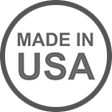Below is a collection of commonly asked questions and answers about Proposition 65 for California residents. In addition, we have provided references at the end of the article so you can do further research if you desire.
What is Proposition 65?
Proposition 65 (known as Prop 65) is a California labeling law meant to notify residents in California of exposure to any of over 800 chemicals and heavy metals at certain threshold limits. For more information go to www.P65Warnings.ca.gov.
It is important to understand that Prop 65 warning notifications are only required under California law for residents of California. It is not a Federal law and it is not intended to ban the sale of any products in California, rather to simply require warnings.
As stated by the California Office of Environmental Health Hazard Assessment, a “Proposition 65 warning does not necessarily mean a product is in violation of any product-safety standards or requirements.” (1)
Are Any Companies Exempt from Prop 65 Requirements?
Yes. Businesses with less than 10 employees and government agencies are exempt from Proposition 65’s warning requirements and prohibition on discharges into drinking water sources. (9)
As Perfect Supplements is under 10 employees, we are currently exempt from this labeling requirement. Nonetheless, for full transparency, we will voluntarily show the Prop 65 warning to California residents when necessary.
Do You Need to Show A Warning If A Product Contains Any Amount of The Listed Substances in Prop 65?
A business has “safe harbor” from Proposition 65 warning requirements or discharge prohibitions if exposure to a chemical occurs at or below these levels.(9)
In plain terms, if a product has under a set threshold level for a chemical or heavy metal, it does not need to display the warning. The threshold limits vary from chemical to chemical.
Are Prop 65 Thresholds More Strict Than Other Guidelines?
With over 800 chemicals on the Prop 65 list, we can not go over the safe harbor threshold limits for each, but we do want to focus on lead levels.
As we explained in our Heavy Metal FAQ, here are threshold limits set by various agencies…
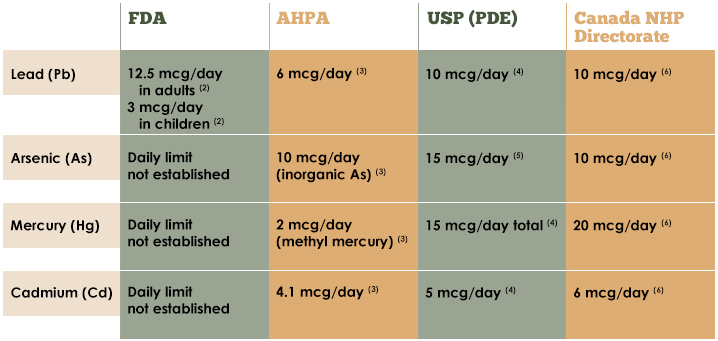
FDA = Food and Drug Administration
AHPA = American Herbal Products Association
USP = United States Pharmocopoea
PDE = permitted daily exposure
NHP = Natural Health Products
mcg = micrograms
1 Microgram = 1/1,000,000 of a gram – yep, 1 millionth of a gram – so we are talking very small numbers.
Now let’s add in the threshold limits for Proposition 65 that would require a warning for California residents…
We have highlighted the lead threshold for Prop 65 to show how much more strict it is than the other agencies.
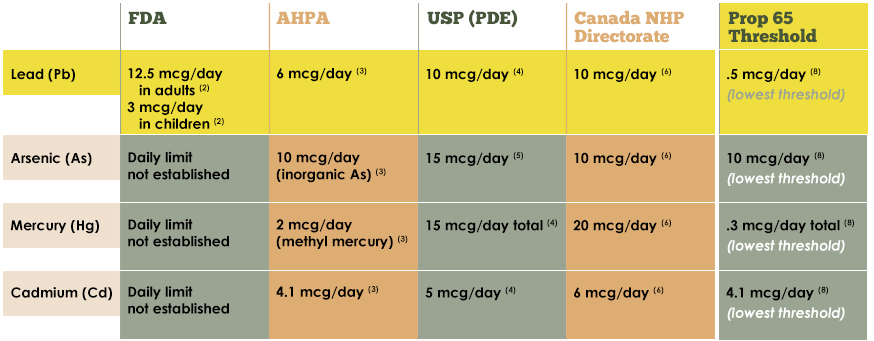
Prop 65 Threshold Levels for Lead are...
25x Lower
than the
FDA Levels
for adults
20x Lower
than the
USP & Canada Levels
12x Lower
than the
AHPA Levels
Why Are Prop 65 Levels For Lead Set At Just .5 mcg?
California uses this criteria when determining the threshold limit – “…that the exposure will have no observable effect assuming exposure at one thousand (1000) times the level in question…”(10)
Again, we encourage you to do your own research, but here is our reading of the regulation. They are looking at lead for what is called the “no observable effect level” (NOEL). They then decided to build in a very large safety margin into the NOEL by dividing it by 1,000 and using that as the threshold level.
This means companies must put a warning on their product if the lead levels are 1/1000 of the no observable effect level (NOEL).
Can You Give Me Some Idea of Lead Levels in Foods?
Obviously, levels will vary greatly based on where the food is grown, how it is grown and the manner in which it is processed.
One of the best primary sources we have found for looking at lead levels in food is The US FDA Total Diet Study (2006-2013). The FDA samples a wide variety of foods over years and reports on, among other things, heavy metal levels in their testing.
To give you a point of reference, below we show a variety of foods from the FDA Total Diet Study (7) and both their average and maximum lead levels that were observed in the study, as calculated for a serving.
| Average Lead Levels | Maximum Lead Levels | ||
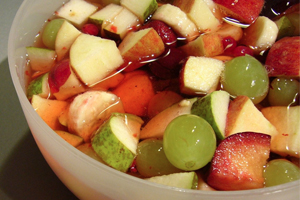
Fruit Cocktail, |
2.34 mcg |
5.85 mcg |
|

Pineapple, |
.854 mcg |
5.61 mcg |
|

|
.77 mcg |
15.3 mcg |
|

|
1.03 mcg |
4.26 mcg |
|
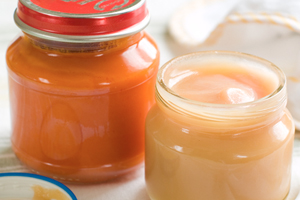
Baby Food, |
.91 mcg |
2.38 mcg |
|

Milk Chocolate Bar |
.66 mcg |
1.62 mcg |
This means that every one of the foods listed above, at just a single serving per day, at both average and maximum levels, would trigger a Prop 65 warning for lead.
If I See A Prop 65 Warning On a Product, Does That Mean It Is Unsafe?
No. As stated by the California Office of Environmental Health Hazard Assessment, a “Proposition 65 warning does not necessarily mean a product is in violation of any product-safety standards or requirements.”(1)
We require all of our ingredient suppliers to provide lab assays showing that they meet or exceed any established federal guidelines for heavy metals. In addition, throughout the year we do spot testing of our finished products.
Safety of our customers has, is and always will be our top concern. We have pioneered an extra layer of testing by doing the Perfectly Pure testing certification.
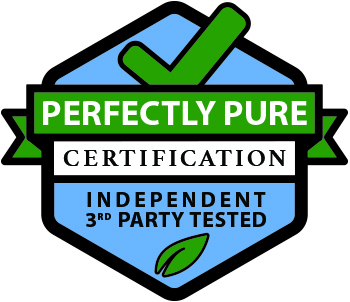
In addition, because we value any initiative that encourages testing and transparency, we are voluntarily complying with Prop 65 even though our company is exempt because of the low number of employees.
How Can I Learn More About Heavy Metals?
We have created a Heavy Metal FAQ that provides more information about heavy metals and the testing that we do on our products. If you want to learn more, head over to the Heavy Metal FAQ.
What Do We Think of How Prop 65 Has Been Implemented?
We applaud the intent of Prop 65 – we are all for transparency and lab testing. The problem is, with threshold limits for lead set so far below other agencies, it creates a situation where so many products carry a warning, it starts to lose its significance. We are hopeful that changes will be made to the thresholds limits in Prop 65 to make it more impactful.
We will continue to provide lab testing and research to our customers so they can make the most informed decisions for themselves and their loved ones.
Any questions – please let us know!
- https://oehha.ca.gov/media/downloads/faqs/p65faqs.pdf
- While The U.S. Food and Drug Administration (FDA) has not established regulatory limits for heavy metals in finished food products other than bottled water, they do set the current IRL (Interim Reference Level) at 3 micrograms (mcg) per day for children and 12.5 mcg per day for adults from food products. https://www.fda.gov/food/metals-and-your-food/lead-food-foodwares-and-dietary-supplements
- AHPA: (American Herbal Products Association) - https://www.ahpa.org/Portals/0/PDFs/Policies/Guidance-Policies/AHPA_Heavy_Metals_Guidance.pdf
- USP (United States Pharmocopoea) - https://tools.thermofisher.com/content/sfs/brochures/WP-71654-ICP-MS-Trace-Elemental-Contaminants-Dietary-Supplements-WP71654-EN.pdf
- https://chemicalsolutionsltd.com/regulations/usp-2232/
- https://www.canada.ca/en/health-canada/services/drugs-health-products/natural-non-prescription/legislation-guidelines/guidance-documents/quality-guide.html
- FDA Total Diet Study- https://www.fda.gov/media/77948/download
- https://oehha.ca.gov/proposition-65/proposition-65-list
- https://oehha.ca.gov/proposition-65/businesses-and-proposition-65
- https://leginfo.legislature.ca.gov/faces/codes_displaySection.xhtml?lawCode=HSC§ionNum=25249.10.









